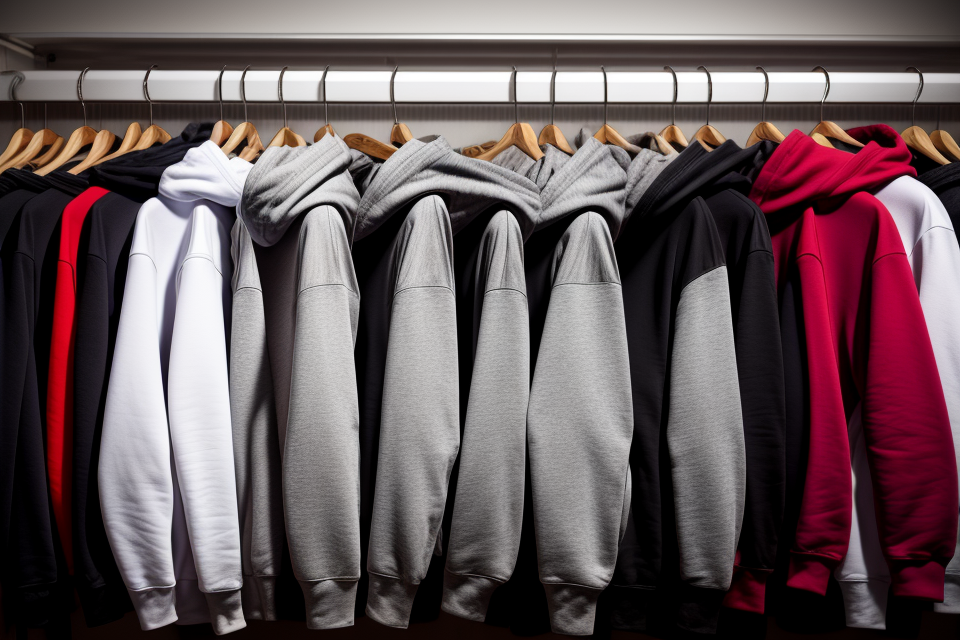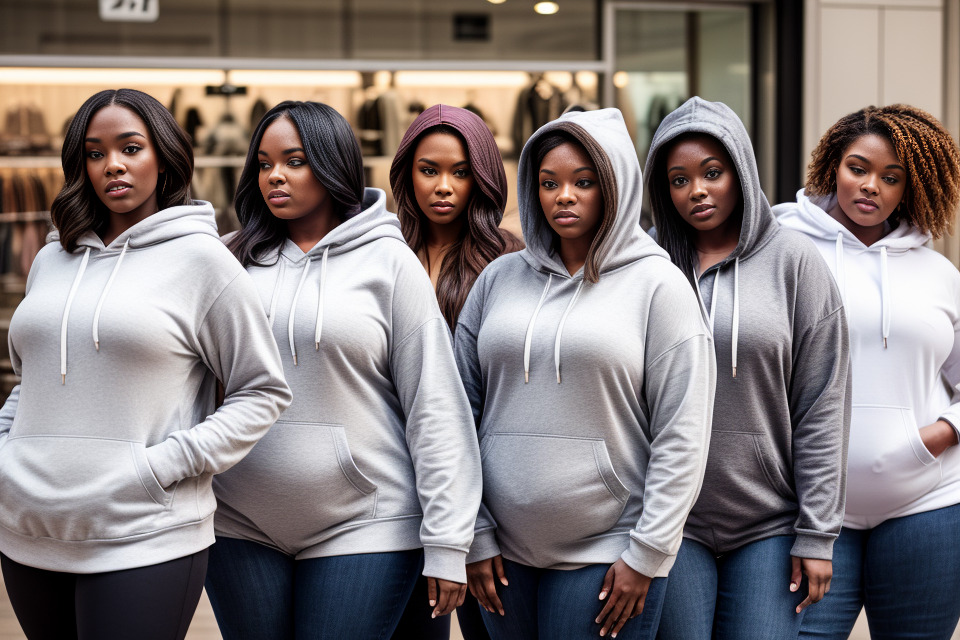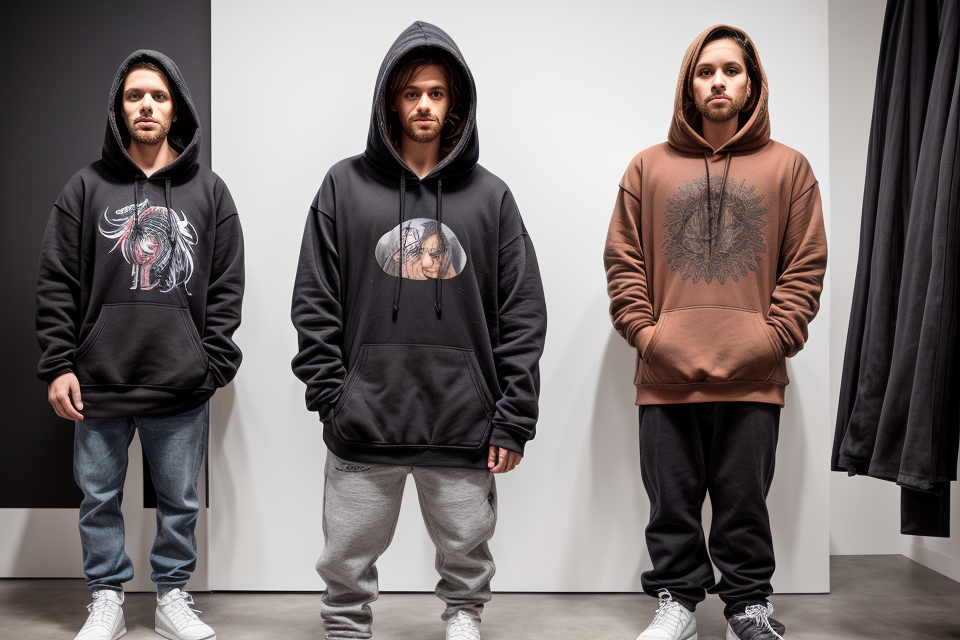
Hoodies have become a staple in many wardrobes, offering both style and functionality. But when it comes to choosing the best quality hoodie, the options can be overwhelming. From materials to fit, there are many factors to consider. In this comprehensive guide, we’ll explore the different qualities that make a hoodie great, helping you make an informed decision that suits your needs and preferences. Whether you’re looking for a cozy, comfortable hoodie for lounging or a durable, high-performance hoodie for outdoor activities, we’ve got you covered. So, let’s dive in and discover what makes a hoodie worth investing in.
When it comes to hoodies, the best quality is one that offers a comfortable fit, durability, and breathability. Look for hoodies made from high-quality materials such as cotton, fleece, or a blend of both. Consider the weight and texture of the fabric, as well as the construction of the hoodie, including the stitching, hemline, and cuffs. Additionally, consider the intended use of the hoodie, such as for athletic activities or everyday wear, as this may impact the desired quality characteristics. Ultimately, the best quality hoodie will depend on your personal preferences and needs.
Factors to Consider When Choosing the Best Quality for Hoodies
Material
When choosing the best quality for hoodies, the material is one of the most critical factors to consider. The material used in the hoodie can affect its durability, comfort, and overall quality. Here are some of the most common materials used in hoodies:
Cotton
Cotton is a popular choice for hoodies because it is soft, comfortable, and breathable. It is also a natural material that is easy to care for. However, cotton hoodies can be prone to shrinking if they are not washed and dried properly. It is important to follow the care instructions on the label to ensure that your cotton hoodie stays in good condition.
Synthetic Materials
Synthetic materials, such as polyester and nylon, are often used in hoodies because they are lightweight, moisture-wicking, and durable. They are also easy to care for and can withstand high temperatures in the wash. However, synthetic materials can be less breathable than cotton and may cause allergic reactions for some people.
Blends
Blends are made from a combination of different materials, such as cotton and polyester. These blends offer the benefits of both materials, such as the softness of cotton and the durability of polyester. Blends can also be moisture-wicking and breathable, making them a popular choice for activewear. However, blends can be more expensive than hoodies made from a single material.
Weight
When choosing the best quality for hoodies, the weight of the fabric is an essential factor to consider. The weight of the fabric refers to its thickness and density, which directly affects the hoodie’s warmth, comfort, and durability. In this section, we will discuss the three main types of weight categories for hoodies: lightweight, midweight, and heavyweight.
Lightweight
Lightweight hoodies are typically made from thin and light fabrics, such as cotton or cotton blends. These hoodies are perfect for spring or summer wear, as they are lightweight and breathable, allowing air to circulate through the fabric. Lightweight hoodies are ideal for casual wear and can be worn as a layering piece over a t-shirt or as a standalone garment. They are not recommended for colder weather conditions, as they do not provide much insulation or warmth.
Midweight
Midweight hoodies are made from thicker fabrics than lightweight hoodies, but they are still relatively lightweight and comfortable. They are made from materials such as fleece, sweatshirt fabric, or cotton blends. Midweight hoodies are suitable for both casual and active wear, as they provide adequate warmth for cooler weather conditions while still being lightweight and comfortable. They are also ideal for layering under a jacket or vest during colder months.
Heavyweight
Heavyweight hoodies are made from the thickest and densest fabrics, such as heavyweight fleece or sweatshirt fabric. They are designed for colder weather conditions and provide excellent insulation and warmth. Heavyweight hoodies are ideal for outdoor activities such as skiing, hiking, or camping, as they can keep you warm in extreme cold temperatures. They are also suitable for everyday wear during the winter months, as they can be worn as a standalone garment or as a layering piece under a jacket or coat.
In conclusion, the weight of the fabric is an essential factor to consider when choosing the best quality for hoodies. Lightweight hoodies are perfect for spring and summer wear, while midweight hoodies are suitable for cooler weather conditions. Heavyweight hoodies are ideal for extreme cold weather conditions and outdoor activities.
Durability
When it comes to hoodies, durability is an essential factor to consider. After all, you want your hoodie to last for a long time and withstand the test of time. Here are some factors to consider when evaluating the durability of hoodies:
Thread Count
The thread count of a hoodie refers to the number of threads used in the fabric. Generally, a higher thread count means a more durable hoodie. This is because the fabric is made up of more threads, which makes it stronger and less prone to ripping or tearing. Look for hoodies with a thread count of at least 100 for maximum durability.
Yarn Quality
The quality of the yarn used in the hoodie can also impact its durability. Look for hoodies made with high-quality yarns, such as cotton or polyester, which are known for their strength and resilience. Avoid hoodies made with cheap or low-quality yarns, as they are more likely to wear out quickly.
Construction
The construction of a hoodie can also impact its durability. Look for hoodies that are constructed with reinforced stitching at the seams, as this can help prevent the fabric from ripping or tearing. Additionally, hoodies with a double-layered hood or reinforced hood drawstring can also provide added durability.
In summary, when evaluating the durability of hoodies, consider the thread count, yarn quality, and construction. Look for hoodies made with high-quality materials and reinforced construction to ensure maximum durability.
Comfort
Softness
When it comes to comfort, the softness of a hoodie is a crucial factor to consider. The material should be soft to the touch, making it comfortable to wear for extended periods. Some materials that are known for their softness include cotton, fleece, and polyester. However, it’s important to note that the softness of a material can vary depending on the type of fabric and the manufacturing process. For instance, ring-spun cotton is known for its softness and durability compared to regular cotton. Additionally, a hoodie with a brushed interior can provide an extra layer of softness against the skin.
Breathability
Breathability is another essential aspect of comfort when it comes to hoodies. A breathable material allows air to circulate, which can help regulate body temperature and prevent overheating. Materials like cotton and mesh are known for their breathability. It’s important to consider the climate you’ll be wearing the hoodie in when choosing a material. For example, if you live in a warmer climate, a hoodie made from a lightweight, breathable material like cotton would be more suitable than a heavy, insulated hoodie.
Moisture-wicking
Moisture-wicking is another essential aspect of comfort when it comes to hoodies. A hoodie that can effectively wick moisture away from the body can help keep you dry and comfortable. Some materials that are known for their moisture-wicking properties include polyester and nylon. Additionally, hoodies with a mesh lining or interior can also help with moisture management. When choosing a hoodie, consider how much moisture you’ll be generating and the climate you’ll be wearing the hoodie in. If you’re active and tend to sweat a lot, a hoodie with moisture-wicking properties would be a suitable choice.
Style
Design
When it comes to choosing the best quality for hoodies, the design is an essential factor to consider. The design of a hoodie can make or break the overall look and feel of the garment.
- Logo Placement: The placement of the logo is crucial in determining the overall style of the hoodie. Logos can be placed on the chest, back, or sleeves, and each placement can create a different look.
- Colors: The colors used in the design can also impact the style of the hoodie. Bold and bright colors can create a fun and playful look, while muted and neutral colors can create a more sophisticated look.
- Graphic: Graphic hoodies are a popular trend, and the graphics used can greatly impact the style of the hoodie. Graphics can range from simple designs to complex patterns, and the choice of graphic will depend on personal preference and the intended use of the hoodie.
Customization
Customization is another important factor to consider when choosing the best quality for hoodies. Customization allows you to personalize your hoodie and make it unique to your style.
- Personalized Text: Many hoodies can be customized with personalized text, such as names or initials. This can add a personal touch to the hoodie and make it a one-of-a-kind piece.
- Embroidery: Embroidery is a popular customization option for hoodies. Embroidered designs can add a touch of elegance and sophistication to the hoodie.
- Material: The material used in the hoodie can also impact the customization options. For example, some materials may be more suitable for embroidery than others.
Quality of Printing
The quality of printing is also an essential factor to consider when choosing the best quality for hoodies. The quality of the printing can impact the overall look and feel of the hoodie.
- Ink Type: The type of ink used in the printing can impact the quality of the print. Water-based inks are more eco-friendly but may not be as durable as plastisol inks.
- DPI: The DPI (dots per inch) of the printing can also impact the quality of the print. A higher DPI means a sharper and more detailed print.
- Printing Technique: The printing technique used can also impact the quality of the print. Direct-to-garment printing is a popular technique that allows for high-quality prints with vibrant colors.
Overall, the style of a hoodie is an essential factor to consider when choosing the best quality. The design, customization, and quality of printing can all impact the overall look and feel of the hoodie. By considering these factors, you can make an informed decision and choose the best quality hoodie for your needs.
Sizing
When it comes to choosing the best quality for hoodies, one of the most important factors to consider is sizing. The right size can make all the difference in how comfortable and stylish your hoodie looks. Here are two options to consider:
Standard Sizing
Standard sizing refers to the sizes that are commonly available in most clothing stores. These sizes are based on height and weight guidelines and are typically measured in inches or centimeters. Standard sizing can be a good option if you are aware of your measurements and know your size. However, it’s important to keep in mind that different brands can have different sizing measurements, so it’s always a good idea to check the size chart before making a purchase.
Custom Sizing
Custom sizing refers to the process of creating a hoodie that is tailored to your specific measurements. This can be a great option if you are between sizes or have unique measurements that don’t fit into standard sizing categories. Custom sizing can be done through a variety of methods, including measuring yourself at home and ordering a made-to-measure hoodie from an online retailer, or working with a tailor to create a custom-fit hoodie. Custom sizing can ensure a perfect fit and a more comfortable and flattering look. However, it can also be more expensive and time-consuming than standard sizing.
Brand Reputation
When it comes to choosing the best quality for hoodies, brand reputation is an important factor to consider. Here are some things to keep in mind when researching a brand’s reputation:
Researching the Brand
Before making a purchase, it’s important to do some research on the brand to determine its reputation. This can be done by reading reviews, checking the brand’s website, and looking at the brand’s social media presence. Some things to look for include the brand’s history, the quality of its products, and its customer service.
Reading Reviews
One of the best ways to research a brand’s reputation is by reading reviews from other customers. This can give you an idea of the quality of the hoodies, as well as the level of customer service provided by the brand. Be sure to read both positive and negative reviews to get a well-rounded view of the brand.
Customer Service
Another important aspect of a brand’s reputation is its customer service. Look for a brand that has a good reputation for responding to customer inquiries and addressing any issues that may arise. This can make a big difference in your overall experience with the brand and the quality of the hoodies you purchase.
Price
Budgeting
When it comes to buying hoodies, one of the most important factors to consider is the price. However, it’s essential to keep in mind that the price alone should not be the deciding factor when choosing a hoodie. It’s important to set a budget before you start shopping and stick to it.
Cost per Wear
Another important factor to consider when determining the best quality for hoodies is the cost per wear. This factor takes into account the lifespan of the hoodie and how many times it can be worn before it needs to be replaced. For example, if a hoodie costs $50 and can be worn 50 times, the cost per wear is $1. Therefore, it’s important to consider how many times you’ll wear the hoodie before determining if it’s worth the cost.
Quality vs. Price
Ultimately, the decision between quality and price depends on your personal preferences and needs. If you prioritize quality, you may be willing to pay more for a hoodie that is made with higher-quality materials and construction. On the other hand, if you’re on a tight budget, you may need to compromise on quality in order to find a hoodie that fits within your budget. However, it’s important to remember that a cheaper hoodie may not last as long or provide the same level of comfort as a higher-quality one. Therefore, it’s important to weigh the pros and cons of each option before making a decision.
Making an Informed Decision
When it comes to making an informed decision about the best quality for hoodies, there are several steps you can take to ensure that you are getting the best possible product for your needs.
Assessing Your Needs
The first step in making an informed decision about the best quality for hoodies is to assess your needs. Consider what you will be using the hoodie for, how often you will be wearing it, and what activities you will be engaging in while wearing it. For example, if you plan to wear your hoodie for outdoor activities such as hiking or camping, you will need a hoodie that is durable and able to withstand the elements. On the other hand, if you plan to wear your hoodie for casual wear, you may prioritize comfort and style over durability.
Prioritizing Your Factors
Once you have assessed your needs, the next step is to prioritize your factors. Determine what is most important to you in a hoodie, whether it be comfort, style, durability, or a combination of these factors. This will help you narrow down your options and focus on hoodies that meet your specific needs and priorities.
Reading Product Descriptions
Another important step in making an informed decision about the best quality for hoodies is to read product descriptions carefully. Pay attention to details such as the materials used, the fit of the hoodie, and any special features or design elements. This will give you a better understanding of the hoodie’s quality and whether it meets your needs.
Asking for Recommendations
Asking for recommendations from friends, family, or online communities can also be a helpful way to make an informed decision about the best quality for hoodies. Look for reviews and testimonials from people who have purchased and worn the hoodie you are considering. This can give you valuable insights into the hoodie’s quality, comfort, and durability.
Trying on Hoodies
Trying on hoodies in person is the best way to get a sense of their quality and fit. Visit a store and try on several different hoodies to see which ones feel the most comfortable and well-made. Pay attention to details such as the thickness of the fabric, the quality of the stitching, and the fit of the hoodie.
Being Open to Different Styles
Finally, be open to different styles of hoodies. There are many different styles available, from classic cotton hoodies to trendy fashion hoodies. Consider trying out different styles to find one that you feel comfortable and confident in. This will help you make an informed decision about the best quality for hoodies based on your personal preferences and needs.
FAQs
1. What makes a hoodie high quality?
A high-quality hoodie is typically made from premium materials such as cotton, fleece, or a blend of both. The fabric should be soft, comfortable, and durable, able to withstand repeated washing and wear. The design and construction of the hoodie should also be well thought out, with a good fit, comfortable hood, and high-quality stitching. Additionally, a high-quality hoodie may feature extra details such as double stitching, reinforced seams, or even custom artwork.
2. What are the different types of hoodies available?
There are several types of hoodies available, including basic pullover hoodies, zip-up hoodies, and oversized hoodies. Basic pullover hoodies are the most common and are typically made from a single layer of fabric. Zip-up hoodies have a zipper down the front, which makes them more versatile and allows for more ventilation. Oversized hoodies are designed to be loose-fitting and are often worn as a fashion statement.
3. What materials are best for hoodies?
The best materials for hoodies are cotton, fleece, and a blend of both. Cotton hoodies are comfortable, breathable, and durable, making them a popular choice. Fleece hoodies are warm and cozy, making them ideal for colder weather. Blend hoodies offer the best of both worlds, with the softness of cotton and the warmth of fleece.
4. How do I choose the right size hoodie?
Choosing the right size hoodie is important for both comfort and fit. Measure your chest, waist, and length of your arms to determine your size. Keep in mind that hoodies can vary in fit, so it’s a good idea to read reviews and compare sizes before making a purchase. If you’re unsure, it’s always a good idea to go with a size up for a looser fit or a size down for a more fitted look.
5. How do I care for my hoodie?
Caring for your hoodie properly will help it last longer and maintain its quality. Machine wash your hoodie in cold water and avoid using bleach or fabric softener. Tumble dry on low heat or air dry. Avoid ironing the hood or any decorative details, as this can damage the fabric. If you need to, spot clean any stains with a damp cloth.


